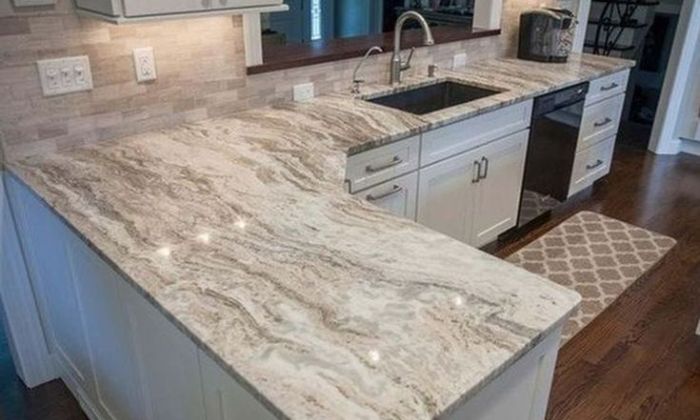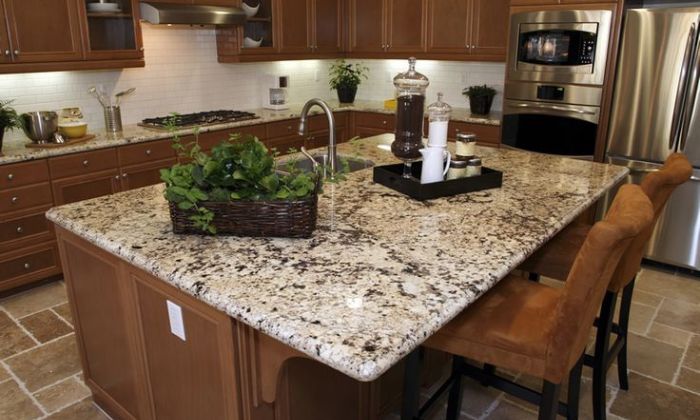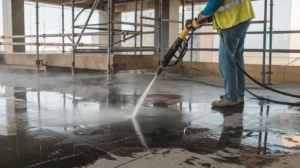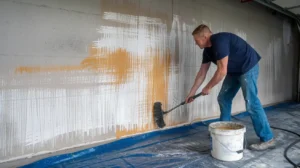When choosing natural stone countertops for your kitchen or bathroom, two of the most popular options are quartzite vs granite. Both stones offer unique benefits and drawbacks, making the decision a bit overwhelming. Understanding their differences in composition, appearance, durability, and more will help you make the right choice. In this article, we will explore quartzite vs granite in-depth, covering everything you need to know to select the best material for your home.
What is Quartzite?
Quartzite is a naturally occurring metamorphic rock that forms when sandstone undergoes extreme heat and pressure over millions of years. This transformation makes it incredibly durable and resistant to scratches, heat, and other types of wear and tear. It’s a dense stone, highly prized for its extremely durable surface that can withstand daily use in a kitchen or bathroom.
Quartzite countertops are often found in neutral tones, though colors and patterns can vary greatly depending on the minerals in the stone. Some quartzite can even have beautiful swirls or veins of color, making it a popular choice for those looking for a natural stone with elegant patterns.

Image by Talkdecor
What is Granite?
Granite is an igneous rock that forms from cooled magma beneath the Earth’s surface. It is a popular option for kitchen countertops due to its scratch resistance and ability to withstand heavy use. Granite slabs are typically polished to enhance their natural shine, making them highly appealing in both modern and traditional settings.
Known for its rugged beauty and strength, granite countertops come in a variety of colors and patterns, thanks to the minerals within the rock. Granite is widely available and is often considered one of the best natural stones for kitchen and bathroom surfaces.

Image by Designing Idea
Quartzite vs Granite: Key Differences
Although quartzite and granite share some similarities, they also have distinct differences. Understanding these differences will help you choose the right material for your home.
Composition
Granite is an igneous rock formed from cooled magma. Its composition includes quartz, feldspar, and mica, which gives it its characteristic speckled appearance. Due to its mineral content, granite slabs come in a variety of colors and patterns, making it a versatile option for countertops.
On the other hand, quartzite is a metamorphic rock created when sandstone undergoes heat and pressure over time. Quartzite is primarily composed of quartz, which is why it’s often mistaken for quartz. It is known for its natural veining, which can mimic marble. While both stones are hard, quartzite is generally harder than granite, making it more durable and resistant to scratching.
Appearance
Both materials have distinct visual qualities. Granite countertops offer a variety of colors and patterns, ranging from speckled to veined designs. It has a more uniform appearance compared to quartzite and is generally polished to a shiny, reflective surface.
Quartzite, on the other hand, typically features more pronounced veining and unique patterns, often with softer colors. This natural stone mimics the look of marble, which can add elegance and sophistication to any space.
Durability
When comparing granite hardness and quartzite’s strength, both are incredibly durable, but quartzite stands out. Quartzite is naturally denser and harder, making it more resistant to wear and tear over time. It can handle heavy use in a busy kitchen, and its hardness also contributes to its resistance to scratches and chips. Granite is slightly more porous than quartzite, which makes it more prone to staining if not properly sealed.
Heat Resistance
Both quartzite countertops and granite can handle high temperatures, making them ideal for kitchen countertops. However, granite is particularly known for its heat resistance, and you can place hot pans directly on the surface without fear of damaging it. While quartzite is heat-resistant as well, extreme heat from hot pans can cause some discoloration or surface damage if left unchecked.
Moisture Resistance
Granite is a naturally porous stone and requires sealing to prevent moisture from penetrating its surface. While granite stain resistance is good, it can absorb liquids like oil, wine, or vinegar if not properly sealed. Regular sealing helps to maintain granite’s resistance to moisture.
Quartzite is less porous than granite, offering better moisture resistance. This means it is less likely to absorb liquids or harbor bacteria, making it a great choice for kitchen and bathroom use.
Maintenance
Both materials require some level of maintenance, but granite countertops typically need to be sealed periodically to maintain their stain resistance. This can be a bit of a hassle for some homeowners but is an essential part of keeping granite looking pristine. On the other hand, quartzite requires less sealing but should still be sealed initially and maintained properly.
Granite’s stain resistance makes it easier to maintain, while quartzite, with its natural stone countertops surface, may require more attention to avoid staining, especially in the kitchen.
Cost
When it comes to cost, quartzite tends to be more expensive than granite. Due to its unique formation process, which requires more energy and time, quartzite is often priced higher than granite. Additionally, the rarity and beauty of quartzite make it a luxury material in some markets. Granite, on the other hand, is more affordable, though the price can vary depending on the quality of the stone and its origin.
Color Variation
Granite offers a broader spectrum of colors, including deep reds, blues, and greens, as well as neutral shades. Its availability and variety make it an excellent choice for various kitchen countertop styles.
Quartzite typically comes in softer, more natural hues, such as whites, beiges, and light grays. The colors and patterns of quartzite vary, but it is most well-known for its marble-like appearance, which can be more subdued compared to the boldness of granite.
Pros of Granite Countertops
Durable
Granite is renowned for its durability, making it an ideal choice for kitchen countertops. Its dense, hard surface is resistant to scratches, chips, and wear, ensuring that it can withstand heavy use in a high-traffic area like the kitchen. Unlike softer materials, granite does not easily show signs of damage from knives, heat, or acidic substances. This resilience helps maintain its appearance over time, making it a long-lasting investment. Additionally, granite’s natural stone composition makes it less prone to staining, further enhancing its suitability for busy kitchen environments.
Heat Resistant
Granite countertops are known for their exceptional heat resistance. You can safely place a hot pan or dish directly on a granite surface without worrying about causing damage or discoloration. Granite’s natural composition allows it to withstand high temperatures, making it a practical choice for kitchens where cooking involves frequent use of hot cookware. However, while granite is heat-resistant, it’s still advisable to use trivets or hot pads to protect the edges and seams of the countertop, as extreme temperature fluctuations could potentially cause minor issues over time.
Variety
Granite offers a wide range of colors, patterns, and textures, making it a versatile material for any space. Whether you prefer classic shades like black, white, or gray, or more exotic options with rich hues of blue, green, or red, granite has something to suit every taste. Its unique natural veining and speckling patterns ensure that no two slabs are exactly alike, allowing you to choose a design that fits your aesthetic preferences. This variety makes granite an ideal choice for countertops, flooring, and other surfaces, offering endless possibilities for customization.
Affordable
Granite is generally more affordable than quartzite, making it an excellent choice for homeowners on a budget. While both materials offer durability and aesthetic appeal, granite’s lower cost gives it a competitive edge for those looking to renovate or build without breaking the bank. The price difference arises from the natural sourcing and processing costs, as quartzite tends to be rarer and more expensive to extract. Despite the lower price, granite still provides a high-quality, long-lasting surface, making it a practical and cost-effective option for countertops, flooring, and other home features.
Cons of Granite Countertops
Porous
Granite is naturally more porous than quartzite, meaning it has tiny holes or pores that can absorb liquids, making it susceptible to staining. Because of this, granite countertops require regular sealing to protect them from moisture, oils, and other substances that could cause discoloration or damage. Sealing creates a protective barrier on the surface, preventing liquids from seeping into the stone. Without proper sealing and maintenance, granite can absorb spills, leading to stains and bacterial growth. In contrast, quartzite is denser and less porous, making it less prone to these issues, though sealing is still recommended.
Prone to Chips
Granite is known for its durability and strength, making it a popular choice for countertops. However, it is still prone to chips or cracks, especially if a heavy object is dropped on it. While granite can withstand everyday wear and tear, a significant impact from a hard or heavy object can cause a chip or crack, particularly along the edges. Proper care, such as using cutting boards and avoiding dropping heavy items, can help minimize the risk. Regular maintenance and quick repairs can keep granite surfaces looking beautiful and functioning well for years.
Requires Maintenance
Granite and marble countertops require regular maintenance to preserve their durability and aesthetic appeal. Over time, these surfaces can absorb liquids and develop stains, so sealing them periodically is essential. Sealing helps create a protective barrier that prevents moisture and oils from penetrating the stone. Additionally, routine cleaning with mild, non-abrasive products is necessary to avoid damage. By consistently maintaining your granite or marble surfaces, you can ensure their longevity, prevent discoloration, and keep them looking beautiful for years. Regular care is key to sustaining both the functionality and the visual appeal of natural stone countertops.
Pros of Quartzite Countertops
Harder than Granite
Quartzite is a natural stone that is harder than granite, making it more resistant to scratches and damage. Formed from sandstone under high heat and pressure, quartzite is dense and durable, which makes it ideal for countertops, flooring, and other high-use areas. While granite is known for its toughness, quartzite’s hardness provides an extra level of protection against everyday wear and tear, making it a preferred choice for those seeking a more scratch-resistant surface. Despite its strength, quartzite requires proper sealing to maintain its appearance and prevent staining.
Heat Resistance
Quartzite is a naturally heat-resistant stone, similar to granite, which makes it an excellent option for kitchen countertops. Its ability to withstand high temperatures without being damaged or affected by heat is one of its key advantages. This heat resistance allows homeowners to place hot pots and pans directly on the surface without worrying about burns, cracks, or discoloration. Quartzite’s durability and resilience to heat make it a practical and safe choice for high-traffic kitchen areas where cooking activities frequently involve hot objects. It combines functionality with aesthetics, making it both a practical and stylish countertop material.
Unique Appearance
Quartzite is a highly sought-after natural stone known for its luxurious appearance, featuring distinct veining and a marble-like texture. Its elegant look makes it an ideal choice for creating sophisticated, high-end spaces. The unique patterns, which vary from soft, subtle lines to bold, dramatic swirls, give each quartzite surface a one-of-a-kind design. The stone’s natural brilliance and smooth finish provide a refined aesthetic, adding timeless beauty to countertops, flooring, and walls. Its ability to mimic the appearance of marble while offering greater durability and resistance to wear makes quartzite a premium choice for luxury interiors.
Low Maintenance
Quartzite is a low-maintenance natural stone that requires less frequent sealing compared to granite. Its dense and non-porous surface helps resist stains and moisture, reducing the need for regular upkeep. Unlike granite, which often needs periodic resealing to maintain its protective barrier, quartzite naturally maintains its durability with minimal effort. This makes quartzite a practical choice for homeowners seeking a beautiful, resilient countertop or flooring material that doesn’t require constant attention. Regular cleaning is usually enough to keep it looking pristine, saving time and effort in long-term care.
Cons of Quartzite Countertops
More Expensive than Granite
Quartzite tends to be more expensive than granite because of its natural formation process and scarcity. Unlike granite, which is formed from volcanic magma and is widely available, quartzite is a metamorphic rock created when sandstone is subjected to high heat and pressure over millions of years. This lengthy, intricate process makes quartzite harder and more durable but also less abundant. The limited supply, combined with the higher cost of extraction and processing, drives up its price compared to granite. As a result, quartzite is often seen as a premium material for countertops and other surfaces.
Prone to Cracking
Quartzite is a highly durable natural stone, but it is prone to cracking or chipping when subjected to heavy impact. While it is tougher than many other stones, such as marble or granite, quartzite can still fracture under extreme pressure or if a heavy object is dropped on it. Despite this vulnerability, quartzite remains a popular choice for countertops and surfaces due to its overall strength and resistance to wear and tear. Proper care and handling can minimize the risk of cracks, allowing quartzite to retain its beauty and functionality for years.
Requires Sealing
Quartzite, though less porous than granite, still requires sealing to ensure its durability and maintain its appearance. Sealing helps protect the stone from moisture absorption, stains, and daily wear. Without a proper sealant, quartzite can become vulnerable to damage from spills, oils, and acidic substances. Regular sealing helps preserve its natural beauty, making it easier to clean and maintain. To keep quartzite countertops looking their best, it’s recommended to reseal them every one to two years, depending on usage and the type of sealer applied. This routine maintenance ensures long-lasting protection and a stunning appearance.
Quartzite vs Granite – Which is Right for You?
Choosing between quartzite and granite depends on your priorities. Granite is an affordable, durable option with a wide variety of colors and patterns, making it ideal for homeowners seeking beauty and low maintenance without a high cost. On the other hand, quartzite offers a luxurious, marble-like appearance and excels in scratch and heat resistance. While it’s more expensive than granite, its durability and elegance make it a worthwhile investment for those seeking a high-end, long-lasting countertop solution. Consider your budget and aesthetic preferences when deciding which material is the best fit for your home.
Conclusion
Both quartzite and granite have their pros and cons, but when deciding between quartzite vs granite, it’s important to consider your budget, style preferences, and how much maintenance you’re willing to commit to. Both materials are extremely durable and heat-resistant, making them ideal for high-traffic areas like kitchens. Your decision should reflect your needs, aesthetic preferences, and willingness to maintain your countertops.
FAQs
Is quartzite more expensive than granite?
Yes, quartzite is generally more expensive than granite due to its formation process and rarity.
What is the downside to quartzite?
Quartzite can be more expensive and may require more careful handling to avoid cracks or chips.
Is quartzite harder to maintain than granite?
No, quartzite is typically easier to maintain than granite, but both require some level of sealing and care.
Do both quartzite and granite require sealing?
Yes, both quartzite and granite require sealing, although quartzite is less porous and may need sealing less frequently.





